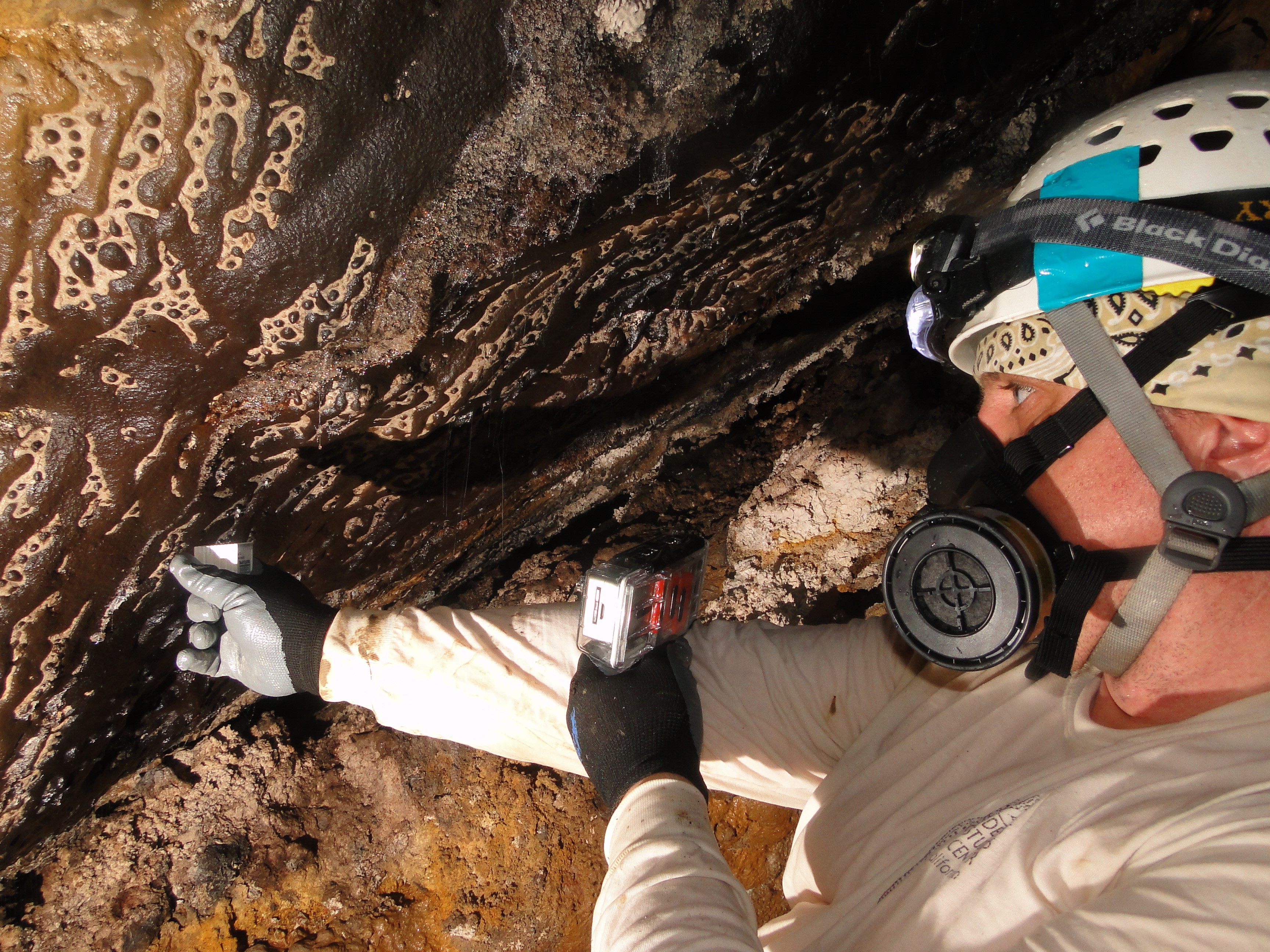Baylor Professor featured in National Geographic for Work in Extreme Environments

Keith Schubert, Ph.D., associate professor of electrical and computer engineering in Baylor University's School of Engineering and Computer Science, photographs biological patterns on a cave wall in Tabasco, Mexico. (Photo courtesy of Val Hildreth-Werker.)
Keith Schubert studies biological patterns that could be 'universal signature'
WACO, Texas (June 23, 2014) – When looking at the series of photos on Keith Schubert's computer screen, most people will likely see what they believe is some sort of black goo arranged like an intricate maze on a rock wall.
But Schubert, Ph.D., associate professor of electrical and computer engineering in Baylor University's School of Engineering and Computer Science, sees life.
Specifically, he sees patterns of life.
From those patterns, Schubert has developed cellular automata and differential equations that he believes can help predict the movement of biological communities as well as the health of extreme environments like deserts, caves and rivers, and, possibly, environments on other planets, like Mars.
That black goo in the photo? Those are billions of microorganisms, Schubert explained. The rock wall? That's the wall of a cave in Tabasco, Mexico. And the cave? Oh yeah, it's suffused with deadly sulfuric acid.
In December, Schubert was a key player on a team of academic and NASA scientists who explored the cave as part of an expedition funded by the National Geographic Society. The expedition is featured in the July issue of National Geographic in an article titled "The Hunt for Life Beyond Earth."
Schubert was invited to be a part of the research group by team leader and colleague Penelope J. Boston, Ph.D., professor of cave and karst science at New Mexico Tech and associate director of the National Cave and Karst and Research Institute. Boston is a renowned scientist and a popular TED Talk speaker who, like Schubert, studies life in extreme environments.
Boston described the expedition team as a "powerful" group of scholars and scientists with whom she'd worked individually but had never pulled together to work collectively.
"This was an opportunity to bring all of these people together for a single expedition," she said. "We had the opportunity to compare our work and see how it all fits together. Keith was a big part of that."
The expedition touched numerous scientific disciplines and is leading to myriad research projects and publications, Boston said.
Schubert's role was to build custom camera equipment, mount that equipment in the cave system and study the resulting images. Those images of the cave wall, which will be taken daily over a minimum two-year period, focus primarily on the intricate patterns formed by the microbes.
"The reason we like the caves is because the caves control the environment, and I can isolate the variables," Schubert said. "The patterns are clearer in the controlled environment, and it's easier to solve for the equation."
He explained that biological organisms tend to congregate where life-sustaining resources are prevalent. Therefore, a dense cluster of microbes indicates that there are nutrients available in that area of the cave wall; thinner clusters of microbes reveal diminished resources; no clusters reveal a lack of resources.
So what does this mean for life outside the cave?
Schubert hypothesizes that scientists might have discovered that the patterns are a "universal signature" among biological populations, something replicated throughout the world. He has seen the same patterns many times before.
"We're finding that it doesn't matter the family of microbes or the chemistry; they all make the same patterns," he said. "All life seems to do this."
The same patterns found in the Mexican cave have been found in tidal pools in California, caves in Hawaii, in the tropics off the coast of Africa, in the cold of Alaska and in the arid deserts of Australia and Israel. The patterns are found among both plant and animal populations.
"Our general belief is that the patterns move toward stability. They harvest the resources and move on," Schubert said. "In human terms, it's the hunter-gatherer concept."
In addition to Baylor University and New Mexico Tech, the expedition team included researchers from NASA, National Geographic Society, New Mexico State University, Universidad Juárez Autónoma de Tabasco and University of New Mexico, as well as private cave researchers and photographers.
ABOUT BAYLOR
Baylor University is a private Christian university and a nationally ranked research institution, characterized as having "high research activity" by the Carnegie Foundation for the Advancement of Teaching. The university provides a vibrant campus community for approximately 15,000 students by blending interdisciplinary research with an international reputation for educational excellence and a faculty commitment to teaching and scholarship. Chartered in 1845 by the Republic of Texas through the efforts of Baptist pioneers, Baylor is the oldest continually operating university in Texas. Located in Waco, Baylor welcomes students from all 50 states and more than 80 countries to study a broad range of degrees among its 11 nationally recognized academic divisions. Baylor sponsors 19 varsity athletic teams and is a founding member of the Big 12 Conference.
ABOUT THE SCHOOL OF ENGINEERING AND COMPUTER SCIENCE
With more than 10 percent of Baylor University's freshman class pursuing major courses of study in the School of Engineering and Computer Science (ECS), the focus remains on preparing graduates for professional practice and responsible leadership with a Christian world view. ECS majors include bioinformatics, computer science, electrical and computer engineering, general engineering, and mechanical engineering. Among ECS graduate programs are Master of Science degrees in all disciplines, a Ph.D. in electrical and computer engineering, and several dual degree programs. The Teal Residential College for Engineering and Computer Science, in which students and faculty live, fosters the pursuit of wisdom, academic excellence, and meaningful relationships for the development of diverse, innovative leaders.